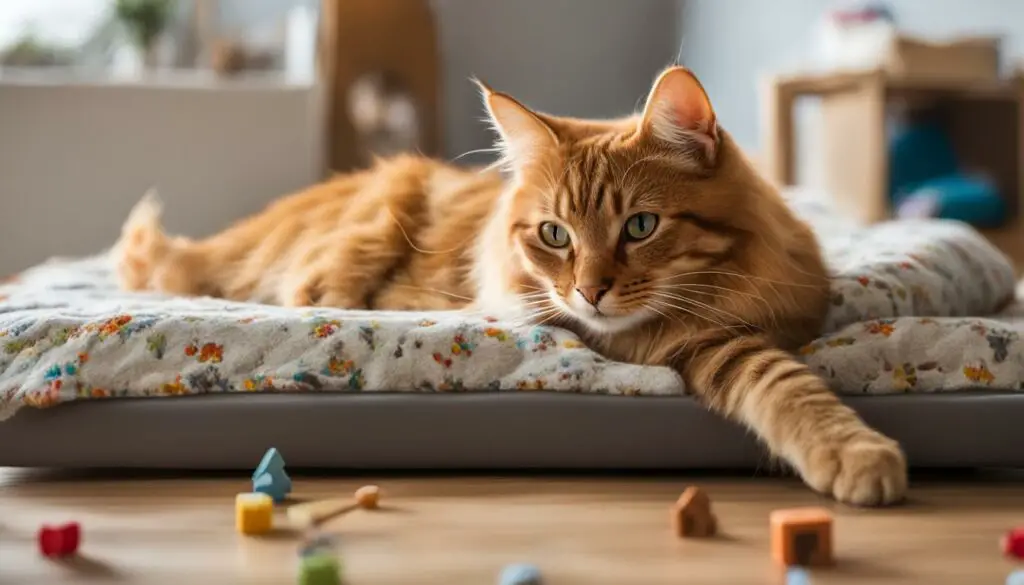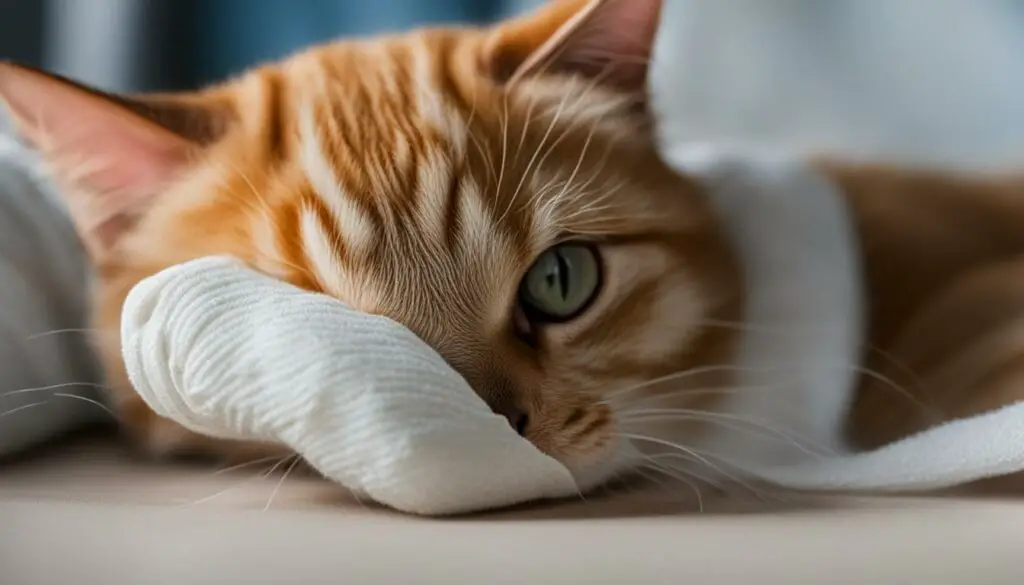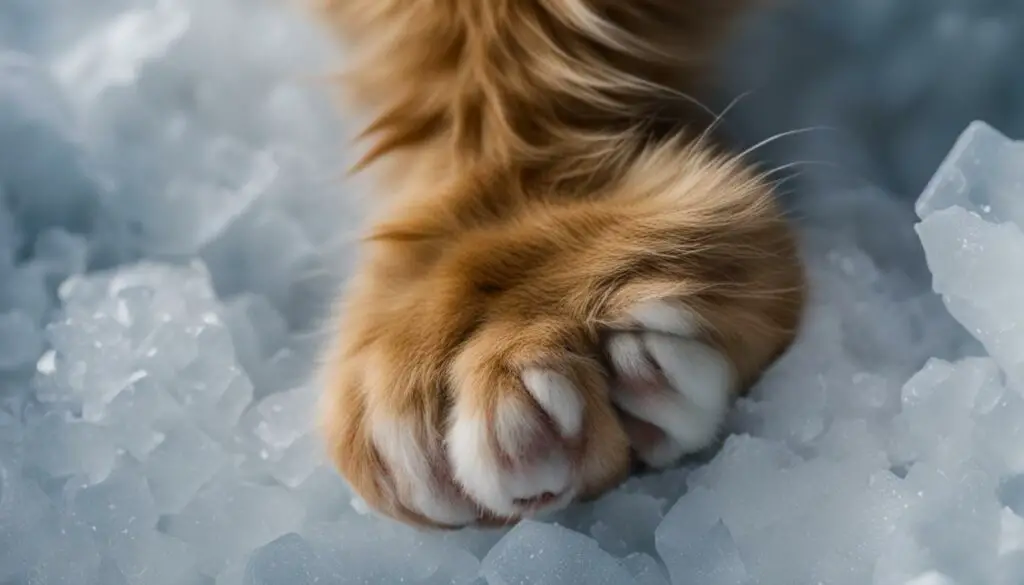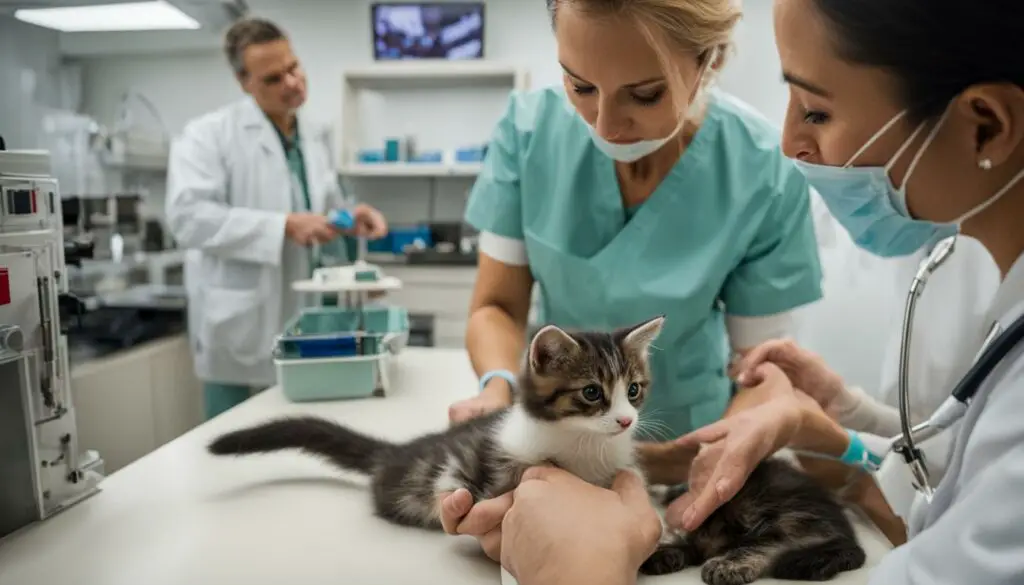As a cat owner, I know how alarming it can be when your precious feline friend takes a tumble from the bed. Whether it’s a cute kitten accident or a cat bed mishap, it’s essential to take the right steps to ensure your cat’s safety and well-being. In this article, I will provide you with valuable tips and advice on how to prevent kitten falls, what to do if your kitten falls off the bed, and remedies to help them recover.
Key Takeaways:
- Even though cats usually land on their feet, they can still sustain injuries when they fall.
- Observing your cat for signs of injury after a fall is crucial, including limping, difficulty breathing, or decreased appetite.
- First aid steps for cat falls involve monitoring their breathing, protecting open wounds, and looking for signs of head or back injuries.
- Delayed injuries may occur hours or days after a fall, so it’s important to closely monitor your cat’s condition.
- Preventing cat falls can be done by providing alternative climbing options, using baby gates, and ensuring a secure bed environment.
Signs of Injury to Watch for After a Fall
After a cat falls off a bed, it’s important to carefully observe them for any signs of injury, even if they initially appear to be fine. Some injuries may not be immediately apparent, and symptoms may only become noticeable hours or even days later. By closely monitoring your cat, you can ensure that any injuries are identified and addressed promptly.
Signs of injury to watch for include:
- Reluctance to stand or walk
- Pain when lying down or rising
- A stiff gait
- Limping
- Difficulty breathing
- Whining
- Lethargy
- Decreased appetite or difficulty eating
If you notice any of these signs after your cat has fallen off the bed, it’s important to seek veterinary care. These symptoms could indicate sprains, broken bones, head trauma, or chest and abdominal injuries. Remember that some injuries may have delayed onset, so it’s crucial to continue monitoring your cat’s condition even if they seem fine immediately after the fall.

First Aid Steps for Cat Falls
If your cat has fallen off the bed and you suspect they may be injured, there are some first aid steps you can take at home before taking them to the veterinarian. These steps include:
- Monitor their breathing: Check if your cat is breathing normally. If there are any signs of difficulty breathing or labored breathing, seek immediate veterinary attention.
- Protect any open wounds: If your cat has any visible wounds or bleeding, gently clean the area with a mild antiseptic solution and cover it with a clean, sterile bandage or dressing.
- Control bleeding: If your cat is bleeding heavily, apply gentle pressure to the wound with a clean cloth or gauze pad to help stop the bleeding. If the bleeding doesn’t stop or continues to be heavy, contact your veterinarian.
- Look for signs of head or back injuries: Observe your cat for any signs of head or back injuries, such as disorientation, difficulty moving their limbs, or loss of consciousness. If you notice any of these signs, seek immediate veterinary care.
- Monitor eating and elimination: Keep an eye on your cat’s eating and litter box habits. If they have difficulty eating or using the litter box, it may indicate an injury. Contact your veterinarian for further guidance.
Remember, these first aid steps are only intended to stabilize your cat and provide initial care. It’s important to seek prompt veterinary attention for serious injuries or if your cat’s condition worsens.
| First Aid Steps for Cat Falls |
|---|
| Monitor breathing |
| Protect open wounds |
| Control bleeding |
| Look for signs of head or back injuries |
| Monitor eating and elimination |

Monitoring Your Cat After a Fall
After a cat has experienced a fall, it is crucial to closely monitor their condition for potential delayed injuries or symptoms. Even if your cat appears fine immediately after the fall, it’s important to remember that some injuries may take time to manifest. By closely observing your cat’s behavior and physical well-being, you can ensure that any potential issues are identified and addressed promptly.
Some signs of delayed injuries in cats include lethargy, weakness, difficulty breathing, and signs of internal injuries. These symptoms can indicate potentially serious complications such as collapsed lungs or hernias. By monitoring your cat’s behavior, eating habits, and overall well-being, you can detect any changes that may indicate the presence of delayed injuries.
Creating a comfortable and quiet space for your cat to rest is essential during the monitoring process. Providing soft bedding and ensuring a stress-free environment will help facilitate their recovery and allow you to easily observe any changes in their condition. Remember to offer gentle petting and soothing words to help reassure your cat during this time.
| Signs of Delayed Injuries in Cats |
|---|
| Lethargy |
| Weakness |
| Difficulty breathing |
| Signs of internal injuries |
By closely monitoring your cat and seeking veterinary care if necessary, you can ensure that any potential injuries or complications from the fall are addressed promptly. Remember, the well-being and safety of our feline friends should always be a top priority.
Preventing Cat Falls
Cats are curious and agile creatures, and sometimes they can’t resist the temptation to jump onto high surfaces like beds. However, as cat owners, it is our responsibility to create a safe environment for our feline friends and prevent them from falling off the bed. Here are some tips on how to keep your cat safe in bed:
1. Provide alternative climbing options:
Cats love to climb and explore, so it’s essential to provide them with alternative climbing options. Invest in a sturdy cat tree or install shelves near the bed where your cat can climb and rest comfortably. By offering these alternatives, you can redirect their attention and reduce the likelihood of them jumping on and potentially falling off the bed.
2. Use baby gates:
If you want to keep your cat out of specific areas, such as your bedroom or the bed itself, consider using baby gates. These gates can restrict access to certain areas, preventing your cat from reaching the bed. It’s important to choose gates that are tall enough to prevent your cat from jumping over them.
3. Create a cushioned landing:
If your cat insists on jumping onto the bed, consider placing cushions or soft surfaces around the bed to create a cushioned landing area. This can help minimize the impact if your cat does accidentally fall off the bed. Opt for materials that are comfortable for your cat but also easy to clean.
Remember, while these measures can significantly reduce the risk of your cat falling off the bed, accidents can still happen. Always keep a close eye on your cat’s behavior and monitor them for any signs of injury or distress. If you have any concerns, consult with your veterinarian for further guidance.

Understanding Soft Tissue Injuries in Cats
Cats are agile animals known for their incredible flexibility and quick reflexes. However, even the most nimble felines are not immune to soft tissue injuries. Soft tissue injuries in cats refer to damages that occur to the muscles, tendons, and ligaments surrounding their bones and joints. These injuries can result from falls, accidents, or even excessive physical activity. Understanding the different types of soft tissue injuries can help cat owners recognize and manage them appropriately.
Cat muscle and tendon injuries can range from minor strains and sprains to more severe tears and ruptures. These injuries often cause pain, swelling, limping, and decreased mobility in affected limbs. It is essential to monitor your cat’s behavior and look for signs of discomfort or distress after a fall or accident. If you notice any abnormalities or suspect a soft tissue injury, it is advisable to consult a veterinarian for a thorough examination and proper diagnosis.
“Soft tissue injuries in cats can be challenging to identify, as cats are experts at hiding discomfort. However, early detection and intervention are crucial for a successful recovery.”
Sometimes, soft tissue injuries in cats may require rest, gentle physical therapy, and pain management. In severe cases where there is significant damage or instability, surgery may be necessary to repair and stabilize the affected area. The recovery period for soft tissue injuries can vary depending on the severity, with some cats fully recovering in a matter of weeks while others may require months of rehabilitation.
Table: Types of Soft Tissue Injuries in Cats
| Injury Type | Description |
|---|---|
| Sprains | Stretching or tearing of ligaments connecting bones |
| Strains | Stretching or tearing of muscles or tendons |
| Bruises | Damage to soft tissues caused by blunt force trauma |
| Ruptures | Complete tearing or severing of muscles or tendons |

Preventing soft tissue injuries in cats can be challenging, but providing a safe and stimulating environment can reduce the risk. Keep hazardous objects and surfaces inaccessible, provide plenty of opportunities for exercise and play, and ensure your cat’s diet supports healthy muscle and bone development. Additionally, regular check-ups with a veterinarian can help identify any underlying health conditions that may predispose your cat to soft tissue injuries.
Treatment for Cat Sprains
When a cat is diagnosed with a sprain, the first line of treatment is usually rest. Restricting the cat’s movement and providing a comfortable area for them to rest can help the injured limb heal. In some cases, non-steroidal anti-inflammatory medications may be prescribed to reduce inflammation and pain. Depending on the severity of the sprain, additional treatments such as splinting or surgery may be necessary. Recovery time can vary, ranging from a few weeks to several months, and the cat’s function in the limb may be limited.
If your cat has recently experienced a sprain, it is important to provide them with the necessary care and support during their recovery. Rest is crucial to allow the injured limb to heal properly. Restricting their movement and providing a quiet and comfortable space for them to rest can aid in the healing process.
Non-steroidal anti-inflammatory medications may be prescribed by your veterinarian to help reduce inflammation and manage the pain associated with the sprain. It is important to follow the dosage instructions provided by your veterinarian and not to give your cat any human medications without consulting with a professional first.
In more severe cases, additional treatments such as splinting or surgery may be necessary. Splinting involves immobilizing the injured limb with a splint or a cast to promote healing. Surgery may be required if the sprain is accompanied by a fracture or if there is significant damage to the ligaments or tendons.
Overall, the recovery time for cat sprains can vary depending on the severity of the injury. It is important to closely monitor your cat’s progress and follow any follow-up appointments or instructions from your veterinarian. With proper care and treatment, most cats will be able to regain function in the injured limb and resume their regular activities.

Table: Recovery Time for Cat Sprains
| Severity of Sprain | Recovery Time |
|---|---|
| Mild Sprain | A few weeks |
| Moderate Sprain | 1-2 months |
| Severe Sprain | Several months |
Managing Soft Tissue Injury In Cats
When a cat experiences a soft tissue injury, proper management is crucial for their recovery. Whether it’s a strain, sprain, or tear, following these steps can help promote healing and provide the best care for your cat.
Rest and Restriction of Movement
One of the most important aspects of managing a soft tissue injury in cats is to allow them to rest and restrict their movement. This gives the injured tissues time to heal without further stress or strain. Create a quiet and comfortable space for your cat, and limit their access to areas where they can potentially aggravate the injury. Consider using a small, confined space or using a pet carrier to ensure they stay still during the initial healing phase.
Appropriate Pain Management
Pain management is essential for cats with soft tissue injuries. Consult with your veterinarian to determine the best course of action for pain relief. They may prescribe pain medications or recommend over-the-counter options that are safe for cats. It’s important to follow the prescribed dosage and monitor your cat for any adverse reactions. If you notice any changes in behavior or worsening of symptoms, contact your vet immediately.
Physical Therapy and Rehabilitation
Physical therapy and rehabilitation can play a crucial role in helping cats recover from soft tissue injuries. This may include gentle exercises, stretching, or the use of assistive devices such as ramps or stairs. Your veterinarian may recommend specific exercises or refer you to a veterinary physical therapist who can guide you through the rehabilitation process. It’s important to start physical therapy under professional guidance to avoid further injury or complications.

In conclusion, managing soft tissue injuries in cats requires a combination of rest, pain management, and physical therapy. By providing a calm and comfortable environment, properly administering medications, and following through with any recommended exercises or rehabilitation, you can help your cat recover from a soft tissue injury and improve their overall well-being.
Caring for Cats with Soft Tissue Injuries
If your cat has suffered a soft tissue injury, it’s crucial to provide them with proper care at home to aid in their recovery. Following the veterinarian’s instructions and creating a calm and comfortable environment are key to helping your feline friend heal. Here are some essential tips for caring for cats with soft tissue injuries:
- Keep any splints or bandages clean and dry to prevent infection and promote healing. Ensure that the edges of the splint are not rubbing against the cat’s skin, as this could cause discomfort or further injury.
- Administer any prescribed medications as directed by your veterinarian. This may include pain relievers or anti-inflammatory drugs to manage pain and reduce swelling.
- Create a quiet and comfortable space for your cat to rest and recover. Provide soft bedding to help cushion their injury and make them feel secure.
- Monitor your cat closely for any changes in their condition. Look out for signs of infection, worsening pain, or difficulty in movement. If you notice any concerning symptoms, contact your veterinarian for further guidance.
By providing the necessary care and attention, you can support your cat’s healing process and help them regain their mobility and well-being. Remember to consult with your veterinarian for specific instructions tailored to your cat’s individual needs.
Table: Recommended Care for Cats with Soft Tissue Injuries
| Care Guidelines | Description |
|---|---|
| Keep splints or bandages clean and dry | Prevents infection and promotes healing |
| Administer prescribed medications | Manages pain and reduces swelling |
| Create a comfortable resting space | Provides a quiet and secure environment for recovery |
| Monitor for changes in condition | Watch for signs of infection, increased pain, or decreased mobility |
Following these care guidelines can help ensure that your cat receives the necessary support during their recovery from a soft tissue injury. Remember to consult with your veterinarian for specific advice and tailored recommendations based on your cat’s unique situation.

Seeking Veterinary Care for Cat Falls
When it comes to cat falls, it’s essential to know when to seek veterinary care. While some falls may result in minor injuries that can be managed at home, others can lead to more serious complications that require immediate attention from a veterinarian. Understanding the signs and symptoms of severe injury is crucial in ensuring the well-being of your feline companion.
If your cat experiences difficulty breathing, excessive bleeding, or shows signs of head or back injuries, it is imperative to seek emergency vet care. These symptoms could indicate internal injuries or fractures that require medical intervention. Additionally, if your cat’s symptoms persist or worsen over time, it is recommended to consult a veterinarian to ensure proper diagnosis and treatment.
Veterinary treatment for cat falls may include thorough physical examinations, X-rays, or even surgery, depending on the severity of the injuries. These interventions are crucial in preventing complications and providing the best possible care for your cat. Remember, prompt veterinary attention is key to facilitating your cat’s recovery and minimizing any long-term consequences resulting from the fall.
| Signs that require immediate veterinary care: |
|---|
| Difficulty breathing |
| Excessive bleeding |
| Signs of head or back injuries |
| Prolonged or worsening symptoms |
In conclusion, if you notice any alarming signs or suspect that your cat has suffered a significant injury from a fall, it is always best to err on the side of caution and seek veterinary care. By doing so, you can ensure that your cat receives the proper treatment and support necessary for a swift and successful recovery.

Supportive Care for Cat Falls
After a cat has fallen off a bed, it is important to provide them with supportive care to aid in their recovery. This involves creating a calm and comfortable environment for them to rest and heal. Place soft bedding in their designated area to provide comfort and warmth. It’s important to monitor their eating, drinking, and elimination to ensure they are maintaining their basic bodily functions.
In addition to physical comfort, emotional support plays a crucial role in a cat’s recovery. Spend time with your cat, offering gentle petting and soothing words. This will help reassure them and alleviate any anxiety or fear they may be experiencing. Remember, your presence and affection can have a positive impact on their overall well-being.
When providing care for a cat after a fall, it’s important to closely observe their behavior and monitor for any signs of additional injuries or complications. If you notice any changes in their behavior or physical condition, it is best to consult with a veterinarian for further guidance and treatment.
| Comfort Measures for Cat Falls | Providing Care for Cat After Fall |
|---|---|
| 1. Creating a calm and comfortable environment | 1. Monitoring eating, drinking, and elimination |
| 2. Providing soft bedding for comfort | 2. Offering emotional support through gentle petting and soothing words |
| 3. Monitoring for changes in behavior or physical condition | 3. Consulting with a veterinarian if any concerns arise |
By implementing these supportive care measures, you can help your cat recover from a fall and provide them with the comfort they need during the healing process.
Tips for Cat Bed Safety
When it comes to ensuring the safety and well-being of our feline friends, choosing the right cat bed is crucial. A safe cat bed not only provides comfort but also minimizes the risk of falls and injuries. Here are some tips to keep in mind when selecting a cat bed:
1. Choose a Low-Sided Bed
Opt for a cat bed with low sides or even no sides at all. High-sided beds may increase the risk of cats falling when they try to jump on or off the bed. By choosing a bed with lower sides, you can help prevent accidental falls and make it easier for your cat to access the bed.
2. Prioritize Non-Slip Materials
Ensure that the cat bed is made from non-slip materials. This will provide stability and prevent the bed from sliding or shifting when your cat jumps or moves around. Non-slip materials like rubber or silicone can help keep the bed securely in place and reduce the risk of falls.
3. Consider Size and Comfort
When selecting a cat bed, consider the size and comfort level for your cat. It should be spacious enough for them to stretch out comfortably. Additionally, choose a bed with soft, supportive padding to provide optimal comfort. Cats are more likely to stay in their bed if they find it comfortable, reducing the chances of them seeking alternative, potentially unsafe sleeping spots.
4. Inspect Regularly
Regularly inspect the cat bed for any signs of wear and tear. Check for loose seams, broken zippers, or other damage that could pose a safety hazard. If you notice any issues, replace the bed promptly to ensure your cat’s safety.
By following these tips and selecting a cat bed that prioritizes safety, you can provide a secure and comfortable sleeping space for your feline companion. Remember, a safe cat bed is an essential part of creating a cat-friendly environment in your home.

Conclusion
After exploring the topic of kittens and cats falling off beds, it is important to remember that most falls are harmless. However, as responsible pet owners, we should always be aware of the potential for injuries and take appropriate measures to prevent them.
By following the tips and advice provided in this article, such as creating a safe environment, monitoring for signs of injury, and seeking veterinary care when necessary, we can ensure the well-being and safety of our feline friends.
Remember, accidents can happen, but with our vigilance and proactive efforts, we can minimize the risks and provide the best care possible for our cats. So, let’s keep our furry companions safe and protected, both on and off the bed.
FAQ
What should I do if my cat falls off the bed?
If your cat falls off the bed, it’s important to observe them for any signs of injury. Look for reluctance to stand or walk, pain when lying down or rising, limping, difficulty breathing, whining, lethargy, or decreased appetite. Serious injuries should be evaluated by a veterinarian, but you can also provide initial first aid at home.
What signs of injury should I watch for after a cat falls off the bed?
Signs of injury to watch for include reluctance to stand or walk, pain when lying down or rising, a stiff gait, limping, difficulty breathing, whining, lethargy, and a decreased appetite or difficulty eating. Some injuries may not be immediately apparent and may only become noticeable hours or days later.
What first aid steps can I take if my cat falls off the bed?
First aid steps for cat falls include monitoring their breathing, protecting open wounds, controlling bleeding, looking for signs of head or back injuries, and monitoring their eating and elimination. These measures can help stabilize your cat and provide initial care before seeking veterinary attention.
How long should I monitor my cat after a fall?
It’s important to closely monitor your cat for several days after a fall, even if they initially seem fine. Cats may seem normal initially but develop symptoms later on. This includes signs of lethargy, weakness, difficulty breathing, or signs of internal injuries. Monitoring your cat closely can catch these issues early and ensure they receive the necessary medical attention.
How can I prevent cat falls from the bed?
To prevent cat falls, provide alternative climbing options such as cat trees or shelves, use baby gates to block off certain areas, place cushions or soft surfaces around the bed, and ensure the bed frame and mattress are secure. By creating a safe environment, you can help reduce the risk of your cat falling off the bed.
What are soft tissue injuries in cats?
Soft tissue injuries in cats refer to injuries to the muscles, tendons, and ligaments that surround the cat’s bones and joints. These injuries can range from bruises and strains to tears and sprains, and can occur from falls and accidents.
How are cat sprains treated?
The first line of treatment for cat sprains is usually rest. Restricting the cat’s movement and providing a comfortable area for them to rest can help the injured limb heal. In some cases, non-steroidal anti-inflammatory medications may be prescribed. Depending on the severity of the sprain, additional treatments such as splinting or surgery may be necessary.
How can I manage soft tissue injuries in cats?
Managing soft tissue injuries in cats involves rest, restricted movement, and providing a comfortable environment for the cat’s recovery. The veterinarian may also recommend supplements, remedies, or medications to promote rest and help the cat stay comfortable during physical therapy.
How can I care for my cat with a soft tissue injury at home?
When caring for a cat with a soft tissue injury at home, it’s important to keep any splints or bandages clean and dry, ensure the edges of the splint don’t rub against the cat’s skin, and administer any prescribed medications as directed. Following the veterinarian’s instructions and providing a calm and comfortable environment can help facilitate the cat’s recovery.
When should I seek veterinary care for cat falls?
You should seek veterinary care for cat falls if there are signs of difficulty breathing, excessive bleeding, signs of head or back injuries, or prolonged or worsening symptoms. Prompt veterinary attention can help ensure proper diagnosis and treatment, and help prevent complications or long-term consequences from the fall.
How can I provide supportive care for my cat after a fall?
To provide supportive care for your cat after a fall, create a quiet and comfortable space for them to rest, provide soft bedding, and monitor their eating, drinking, and elimination. Comfort measures such as gentle petting and soothing words can also help reassure the cat during their recovery process.
What tips can you provide for cat bed safety?
To ensure cat bed safety, opt for beds with low sides or no sides at all, choose beds made from non-slip materials, and regularly inspect the bed for any damage or wear and tear that could pose a risk to the cat’s safety.
Source Links
- https://vcahospitals.com/know-your-pet/first-aid-for-falls-in-cats
- https://wagwalking.com/cat/condition/soft-tissue-trauma
- https://wagwalking.com/cat/condition/sprains








